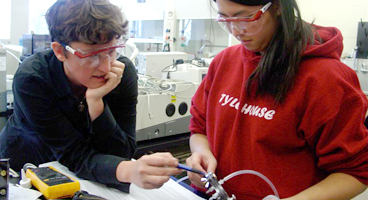Document Type
Conference Proceeding
Publication Date
1-1-2014
Publication Title
ASEE Annual Conference and Exposition, Conference Proceedings
Abstract
The Test of Understanding Graphics in Kinematics (TUG-K) has been modified to produce a Test of Understanding Graphics in Rotational Kinematics (TUG-R) to probe student understanding of rotational kinematics. The seven objectives of the TUG-K were modified with three questions to explore each objective resulting in a 21 question TUG-R which closely parallels the original. For many questions the modification was a simple substitution of the equivalent rotational quantity for its linear counterpart in the question stem, answers and graph- Axis labels. For the remainder of the questions the modification was straightforward. For instance, references to objects moving in a straight line were replaced by references to objects spinning about a fixed axis. The TUG-R was administered to 198 students at a small, liberal arts college in New England. The use of a calculator was permitted and students were offered as much time as they wanted to complete the examination. No inducement or reward was offered to students to take the examination and it was not counted toward their grade in the class. In order to make a more direct comparison to the results of the TUG-K, the data were narrowed to consider only 93 students where the TUG-R was administered post-instruction in both linear and rotational kinematics. This group includes student instruction in a traditional, lecture-based format as well as active engagement classrooms. Approximately 80% of the students were enrolled in an algebra-based course, the remainder in a calculus-based course. Post-instruction student responses on the TUG-K and TUG-R were compared. A 2 tailed z- Test was performed to assess whether or not differences in sample size can account for the differences in results between the TUG-R and TUG-K which are reported. An objective by objective, question by question analysis of the results suggests the three basic types of misconceptions noted following post-instruction analysis of the TUG-K, namely graph type confusion, slope calculation and slope vs. area confusion, continue to be exhibited at some level by students taking the TUG-R. However, significant differences were noted, with TUG-R students performing better on every question in two of the seven objectives on 8 of the 21 questions and equally well on 9 of the remaining 13. Further work will be conducted to verify that these observations and conclusions remain consistent as the testing sample is expanded across a broader spectrum of students of different levels, using different instructional techniques and at a larger cross section of institutions.
Rights
© American Society for Engineering Education, 2014.
Recommended Citation
Turner, Warren A.; Ellis, Glenn W.; and Beichner, Robert J., "A Comparison of Student Misconceptions in Rotational and Rectilinear Motion" (2014). Engineering: Faculty Publications, Smith College, Northampton, MA.
https://scholarworks.smith.edu/egr_facpubs/84



Comments
Archived as published. Open access article.